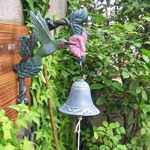 Learning how to fix a doorbell is a skill that will save you time and money. Doorbells are simple electrical devices that are easy to fix or replace. You can buy a entire doorbell kit for under $20 to $50, unless you want something fancy. So this is not an expensive repair.
Learning how to fix a doorbell is a skill that will save you time and money. Doorbells are simple electrical devices that are easy to fix or replace. You can buy a entire doorbell kit for under $20 to $50, unless you want something fancy. So this is not an expensive repair.
There are two types of doorbells, wired and wireless. Wired units are connected to your homes power supply. A transformer is used to reduced the power down to a low voltage. The doorbell buttons and chimes are interconnected with low voltage wire. For information on repairing wired doorbells, see the article 'Fixing Wired Doorbell Units'.
Wireless units work with small transmitters that are powered by batteries. This type of doorbell is easier to install and is an excellent choice for a replacement when the wiring is compromised or not located to your liking. For information of fixing and replacing wireless doorbells see the article 'Fixing and Replacing Wireless Doorbells'.
What Type of Doorbell Do You Have?
How can you identify whether or not your doorbell is wired or wireless. There are several ways that you can do this.
Checking for a Transformer
Wired doorbells use a transformer to provide the low voltage power for the doorbell. So, if you have a transformer that is located somewhere near you your electrical panel, you are pretty sure that you have a wired doorbell.
Checking for Wiring
Checking for wires is another way to tell. Pop the cover off of the doorbell chime unit and look for wires. See any? Or do you see some batteries? Wires mean wired, batteries signify wireless.
Checking for Batteries
Same as the previous subheading, batteries are needed for both the doorbell chime and the doorbell buttons. Fairly simple to remove the covers to look for them.
Fixing Doorbells - Related Articles
Below you will find links to series of articles that discuss the various problems that you are likely to have with your doorbells. Descriptions are provided that will help you zero in on the specific problem you are having. When you follow the links you will find further detail that will help you quickly navigate to the right topic.
Repairing Wired Doorbells
Wired doorbells are tied into your homes power supply via a transformer. The power is reduced down to a low voltage level. Low voltage wiring needs to run from the transformer to the chime unit and then to the doorbells. Most units support at least two doorbell buttons, some support more.
The wiring is fragile and the connections can cause malfunctions. Use this link to find out what you need to do to repair this type of doorbell.
Wiring Doorbells
Generally, you will not want to try and retrofit your home with doorbell wiring if it is not already in place. Understanding how the wiring works will help you to track down a problem you are having. Loose and broken wires are a common problem. The fix could be as simple as cleaning up a wire and reconnecting it.
Repairing Wireless Doorbells
Wireless doorbell units rely on transmitters and batteries to operate. There are not as many things that can be fixed. If repairs can be made, they are usually quite simple. Follow this link to find out what you can do with your wireless doorbell.
Replacing Doorbells
Sometimes, given the cost of a new doorbell, it just makes more sense to replace it. Wired and wireless units can be purchased for a reasonable amount. You might want to weigh the amount of time and trouble involved with trying to repair a doorbell. Replacing it may make more sense. See 'Replacing Wired Doorbells' for units with a transformer. The article 'Replacing Wireless Doorbells' covers the battery operated type. Yes, you can replace a wired unit with a wireless one.
Fixing Doorbells - Finding Help
The introduction to each series of articles has a helpful evaluation section. The "What Can You Save?", "How Hard Could It Be?" and "Tools You Will Need"sections give you a general understanding of the repair and the issues involved. This will help you decide if it is in your best interest to make the repair yourself.
The "Check the Simple Things First" section describes easy repairs that only take a few minutes. In an effort to warn you about what you are in for, there is the "What Can Go Wrong" section. Use this section to benefit from the experience of others, without the discomfort.

